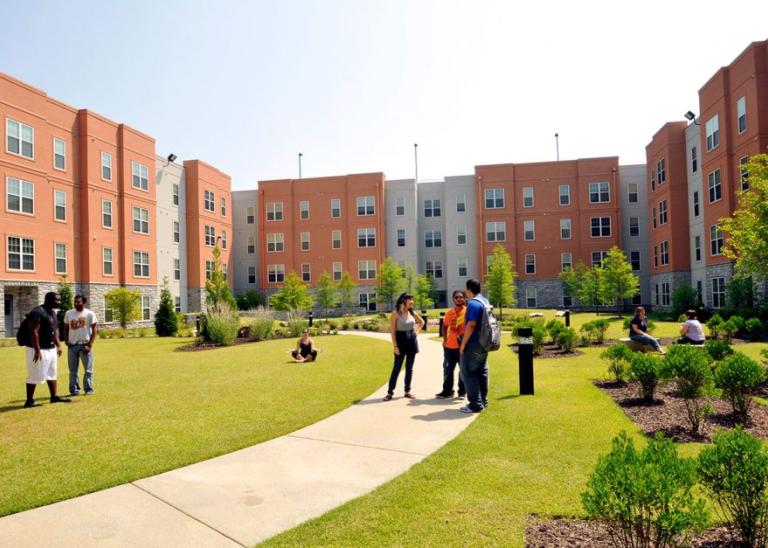Campus Security and Surveillance Technology
By ECAMSECURE 16/05/2017

If you’re in charge of managing security on a college campus, then you’re in charge of managing the safety and well-being of every person on the campus property. Campus crime is a major issue, and statistics show that in 2015 alone there were over 35,000 campus crimes reported nationwide. Employees, students, and visitors all come and go from a campus without giving much consideration to security or safety concerns.
They simply expect that they can go about their day-to-day business without being interrupted or inconvenienced by security problems. This carefree attitude can be safely maintained, but only through careful implementation of the right sort of technology to keep a watchful eye over the property in question.
Increasing campus safety is easy with modern surveillance technology. Here are some strategies that are proven to work:
Electronic Detection System
The primary security goal of a campus property should be to prevent crime, harassment, theft, or property damage from ever occurring in the first place. The best way to achieve this important goal is through the use of electronic detection systems.
Modern electronic detection systems include the most state-of-the-art surveillance technology. Here are some examples:
HD Cameras, IP Networked Cameras
Visual surveillance allows security personnel to monitor large portions of campus property, all from one central monitoring area. A sturdy network of quality video cameras can allow for many security goals to be accomplished, including preventative monitoring, recording criminal activity for review, and confirming possible threats. Additionally, just the visual presence of a security camera will deter many would-be criminals from acting in the first place.
Areas that were once unsafe, remote, or in “blind spots” are now carefully monitored. In this way, a properly installed network of video cameras is perhaps the most critical step in securing a large campus property.
Motion Detection
In areas where full visual surveillance may not be necessary, motion detection sensors represent a reliable alternative. Consider the inside of buildings or classrooms after hours. While hallways and common areas may be monitored by video surveillance, it may be more practical to monitor small areas such as supply closets and individual classrooms with motion detection sensors. This allows for alerts to be made to monitoring stations while avoiding the high cost of installing networked IP cameras in every room.
Video Analytics
Video analytics allow for the careful analysis of security video feeds before human eyes ever even need to be involved. A properly calibrated analytic system can be used to cater video detection to very specific needs. Perhaps you need to know if movement occurs only in a certain area of a camera’s view. Maybe you need to know if vehicles stop at a certain point on campus, or if a crowd is gathering at a certain location. Video analytics can be used to assess these sorts of situations automatically, and to provide the proper alert when needed.
Remote security Monitoring and Virtual Security Officers
No electronic surveillance technology would be effective without someone to monitor for alerts, confirm security issues, and otherwise control the detection system.
Remote Monitoring means that a trained security officer (or team of officers) will be on standby to monitor your surveillance system 24 hours a day, 7 days a week. This creates the constant ability to respond to alerts, confirm their nature, and dispatch the proper response. A monitored detection service will offer better security results, with prioritized response from emergency responders.
Virtual Security Officers take the monitoring process one step farther, tasking a dedicated virtual security officer with monitoring the operation of an electronic detection system. A dedicated virtual security officer can do much more than just respond to, analyze, and dispatch response teams to possible security issues.
A virtual security officer can act as an almost physical presence by communicating with persons on campus ground via two-way radio communication, monitoring them with video camera links, and moving them through physical locations through remote access control management. Imagine a visitor to your campus being able to access a secure area as if he or she had an escort at their side the entire time.
Alarms and Lighting
A final element of securing a campus with surveillance technology is alarms and lighting. Lighting can be a proactive security solution, creating safe spaces where crime is less likely to happen. But lighting is also a critical variable in setting up an effective surveillance system. Video cameras can’t function properly without adequate lighting, and remote monitoring officers can’t confirm threats without being able to see them.
Lighting can also be combined with audio alarm systems to provide an instant deterrent to campus crime. Audible alarms matched with visible strobe lights, for instance, can be activated by remote monitoring services or virtual security officers. This allows for an immediate response to potential threats. Sometimes a loud siren and a flashing light is all it will take to deter a criminal.
Work with experienced security experts to develop a plan for campus safety.


